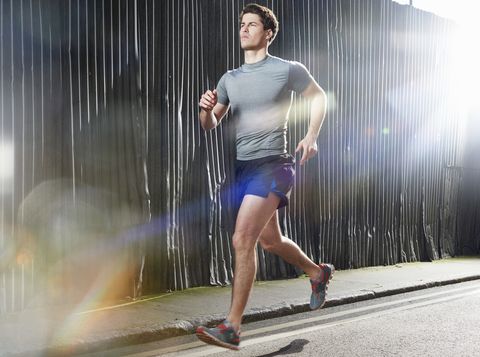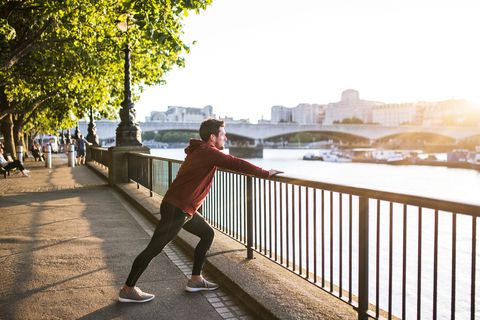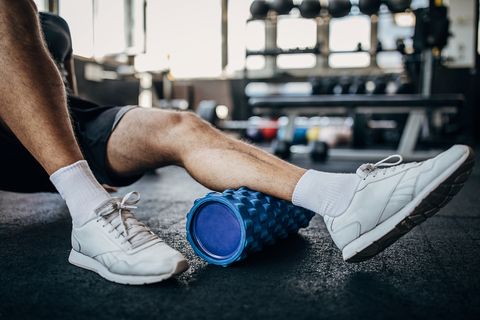The Best Stretches to Help You Get Rid of Shin Splints
If you’ve ever had shin splints, you know how painful the condition can be. Unfortunately, the hurt you’re feeling is usually a consequence of overtraining.
“Shin splints (also known as Medial Tibial Stress Syndrome) is a painful syndrome that is often the results of a ‘too much too soon’ approach to training (in other words, overloading),” says Dr. Rachel Tavel, PT, DPT, CSCS, physical therapist at Shift Wellness in NYC.
Shin splints are essentially caused by micro tears forming along the border of the tibia and lower leg muscles, where they attach to the bone.
“It can feel like a dull ache in the lower leg, along the bottom third of the leg, or like a hammer is pounding at the bone when you walk or run,” says Dr. Tavel. “There is usually some tension/tightness around the area as well.”

But don’t worry if you’re feeling the pain—the condition is also super common and normal.
“Shin splints are very common in the U.S., with more than 3 million cases reported a year,” says Dr. Mirette Mikhail, PT, DPT, CEIS, MTC, CertDN, and clinic director at ATI Physical Therapy.
How To Prevent Shin Splints
If you frequently get shin splints, that may be an indicator of muscle weakness in other parts of your body.
“While shin splints is a common lower leg injury, it is imperative that runners improve hip and core strength simultaneously,” says Dr. Anh Bui, PT, DPT, CSCS, physical therapist in Mill Valley, California. “The glutes, in particular, are the largest, most powerful muscle in the human body and influence control of the knee and ankle joints, which can minimize stress on smaller muscles in the lower leg.”
And while stretching and strengthening is crucial, improving running mechanics is just as important.
“Overstriding is the number one risk factor during running associated with shin splints.” says Dr. Bui. “Landing with your foot far in front of your body increases the impact forces going directly to the tibia (shin bone) instead of being absorbed by larger joints such as the hip. Runners with shin splints should look at their cadence (step rate per minute) and increase by 5 to 10 percent if cadence is less than 180.”
However, the key to preventing shin splints is to address the problem as soon as you start to feel it.
“Once pain starts, a patient should rest the area, apply ice and then massage,” says says Dr. Mikhail. “Consider modifying your sport as running or jumping tends to cause shin splint pain.”
You should also reconsider your shoe selection.
“Proper shoe wear is also important as sometimes a loss of arch support is the cause of shin splints,” adds Dr. Mikhail.
If your shin splints are not going away, you may need to see a doctor.
“You should be referred to a MD to ensure the cause of pain is in fact shin splints and not something more serious, like anterior compartment syndrome,” notes Dr. Mikhail.
If it’s too late and you’re not able to prevent the condition, you do have options. One of the best ways to get rid of shin splints is to stretch out.
Shin Splint Stretches
We asked physical therapists for their favorite stretches to help you alleviate shin splints.
Stretch 1: Kneeling Plantarflexion Stretch
Begin in a tall kneeling position with the tops of your feet on the floor. Sit back onto your legs until you feel a stretch in your feet, and hold this position for 30 seconds.
“Make sure to keep your back straight during the exercise,” says Dr. Mikhail. “Stretch three times daily, seven days a week until pain subsides. After pain subsides, stretch three times daily, three days a week.”
Stretch 2: Standing Gastroc Stretch Off a Step
“Stand with both feet on a step or curb. Lower one heel off of the curb until you feel a mild intensity stretch. Hold for 2 minutes. Low load, long duration stretches deliver the most carryover,” says Dr. Bui. “Spend 2 to 5 minutes total. Make sure you are on muscle, not bone!”
Stretch 3: Soleus Stretch on Wall
Begin in a standing upright position in front of a wall. Place your hands on the wall and extend one leg backward with your front knee bent. Lean forward into the wall until you feel a stretch in your lower calf and hold for 30 seconds. After you’re done with one leg, switch sides and repeat.
“Make sure to keep your heels on the ground and back knee bent during the stretch,” says Dr. Mikhail. “Stretch three times daily, seven days a week until pain subsides. After pain subsides, stretch three times daily, three days a week.”
Stretch 4: Knee Drives for Ankle Dorsiflexion Mobilization
“In a half kneeling position with both knees on the floor, drive the front knee forward aiming towards your pinky toe, while keeping the heel on the ground. Push the knee with your hand as far as it can go without lifting the heel off the ground, hold for 2 seconds, and repeat 20 times/day for about 2 minutes total,” says Dr. Bui.
Stretch 5: Long Sitting Calf Stretch with Strap
Begin sitting on the floor with one foot stretched in front of you, your other knee bent, and a strap secured around your foot. Slowly pull your foot towards you with the strap until you feel a stretch in your calf and hold for 30 seconds. After you’re done with one leg, switch sides and repeat.
“Make sure to keep your knee straight during the stretch,” says Dr. Mikhail. “Stretch three times daily, seven days a week until pain subsides. After pain subsides stretch three times daily, three days a week.”
Alternative Stretch: Self Massage
You can also do some self massage on your shin splints.
“If you want to self massage both the tibialis anterior and tibialis posterior simultaneously, I recommend the Roll Recovery R8 tool,” says Dr. Bui.
Anterior shin splints: For anterior shin splints, you want to self massage painful trigger points in the tibialis anterior muscle (front of the leg).
“Start on your hands and knees. Position the front/outside of the painful leg against a foam roller or lacrosse ball. Cross one leg on top of the other so all your bodyweight is on the front of one leg. Roll up and down to find painful trigger points, then hold pressure on the painful spots, while moving the ankle up and down. When you feel the painful spot release, move on and find the next one,” says Dr. Bui.
Posterior shin splints: For posterior shin splints, self massage the tibialis posterior and calf muscles by first sitting on the floor with both legs straight.
“Place a foam roller or lacrosse ball underneath the back of your leg. Cross one leg over the other. Roll up and down to find the painful spot, then hold the pressure, and move your ankle up and down,” says Dr. Bui.
Source: Read Full Article



